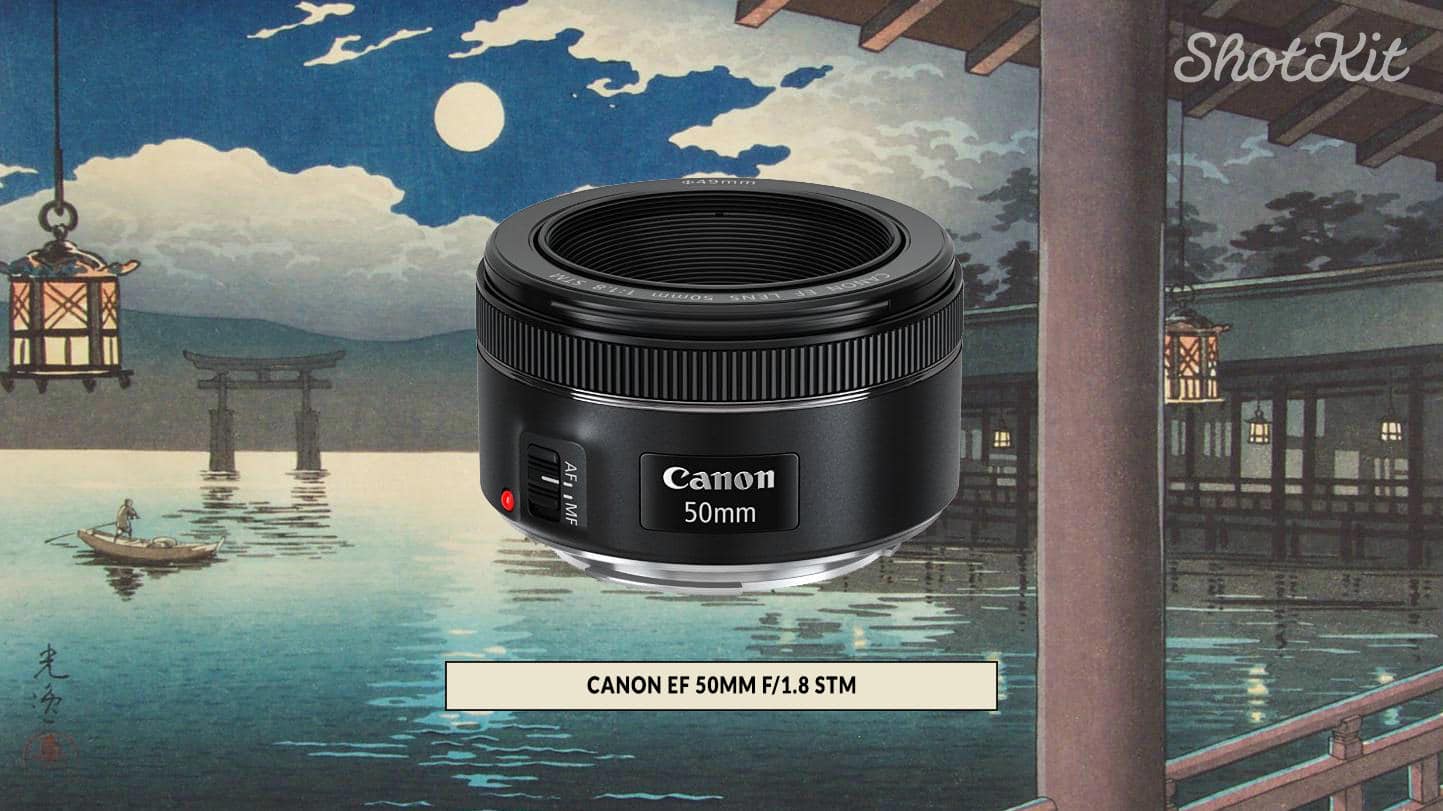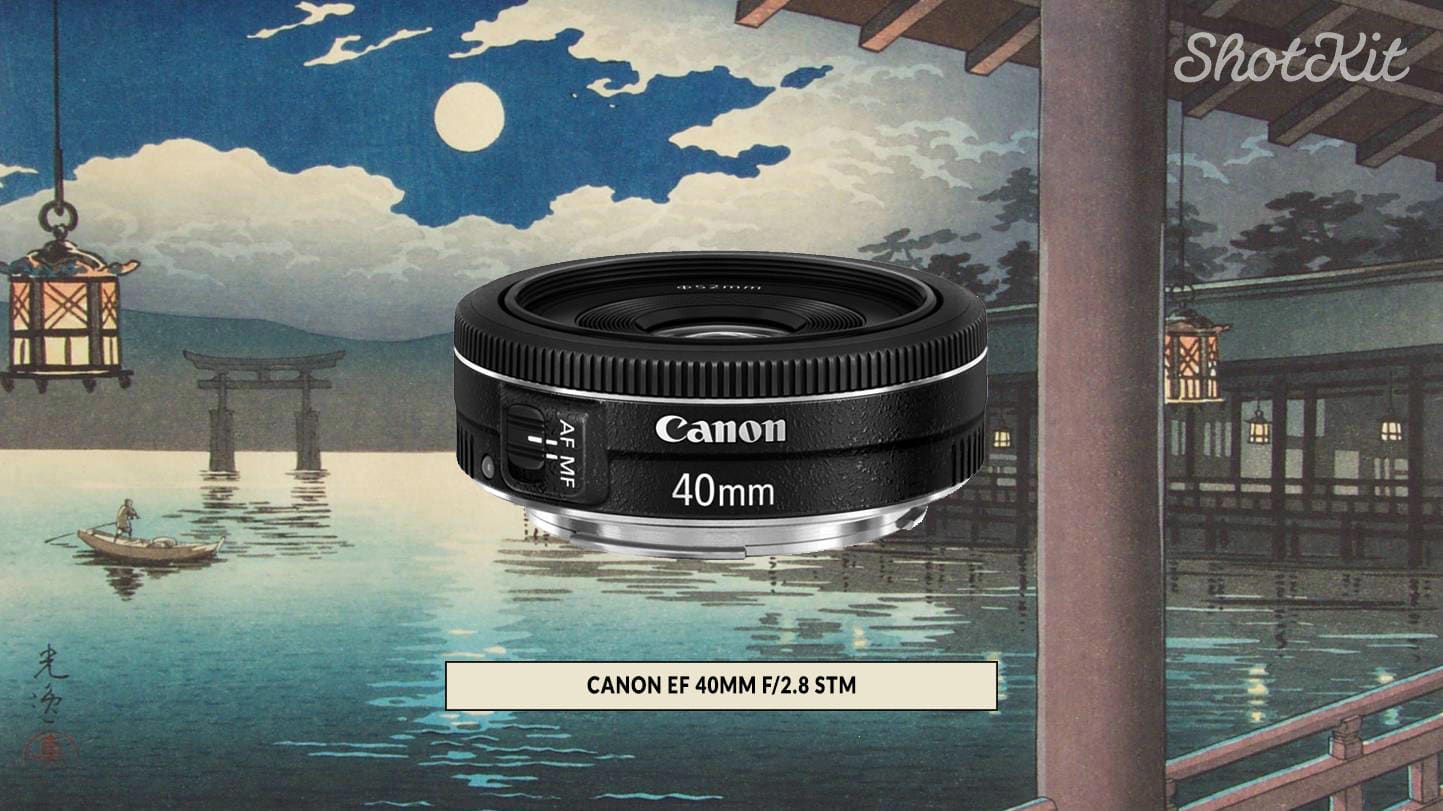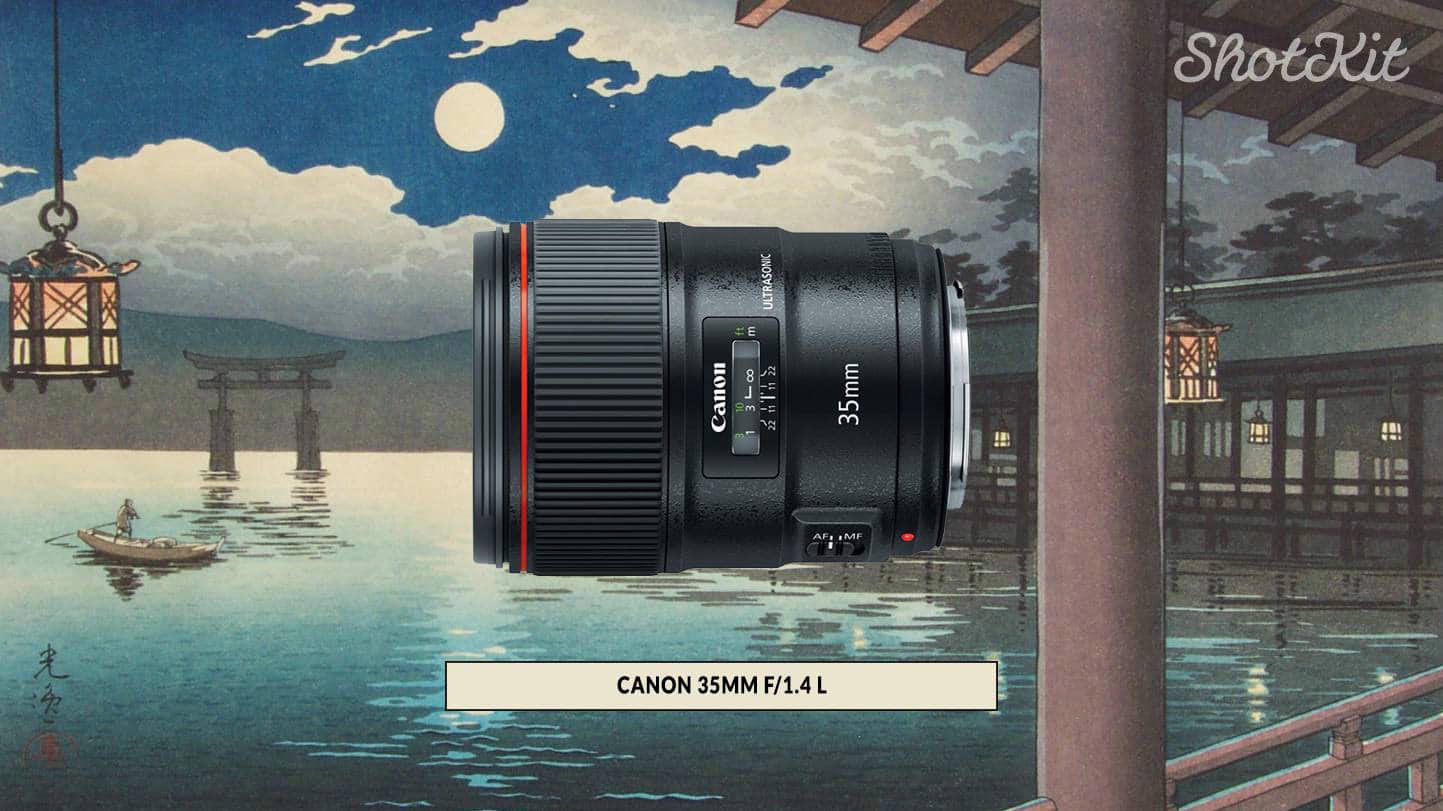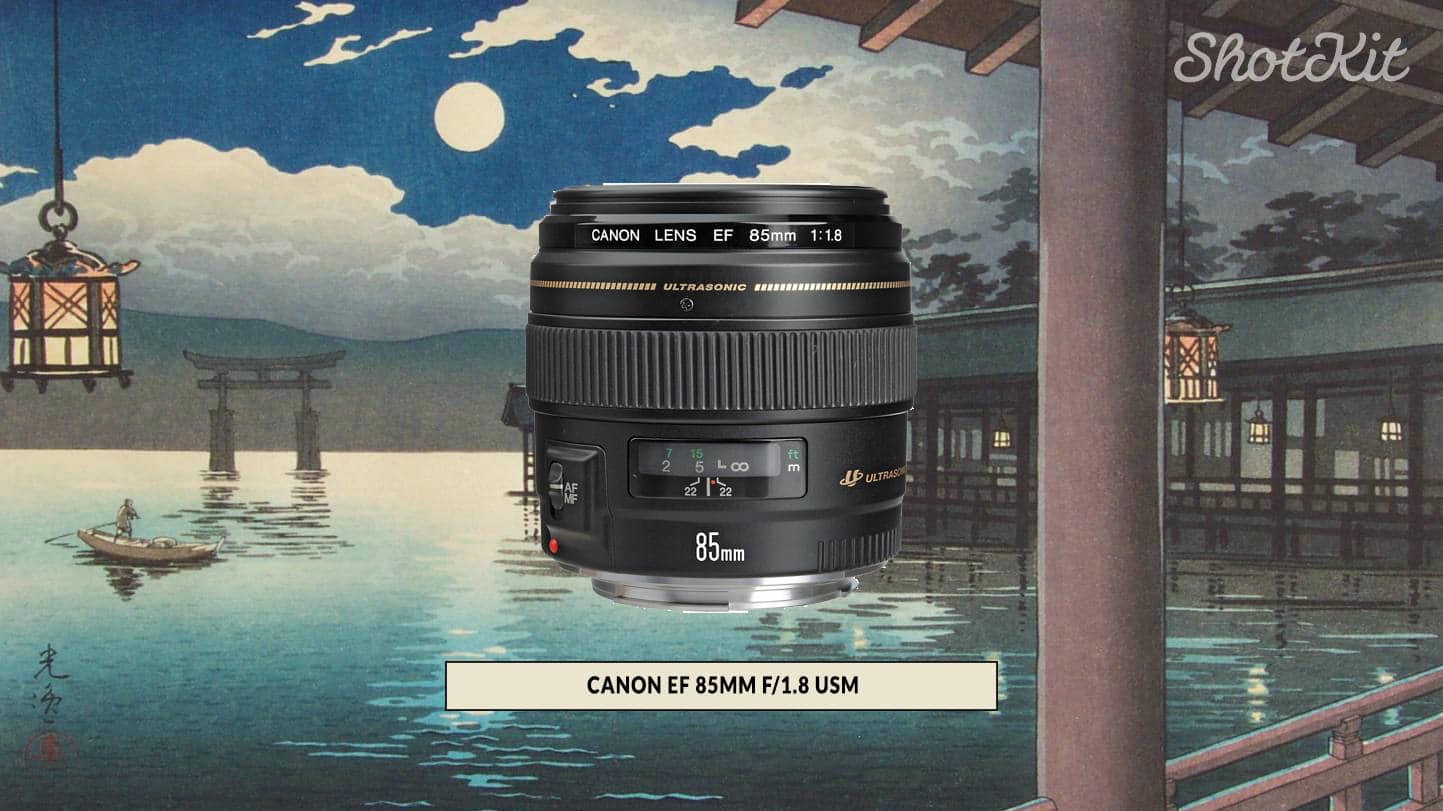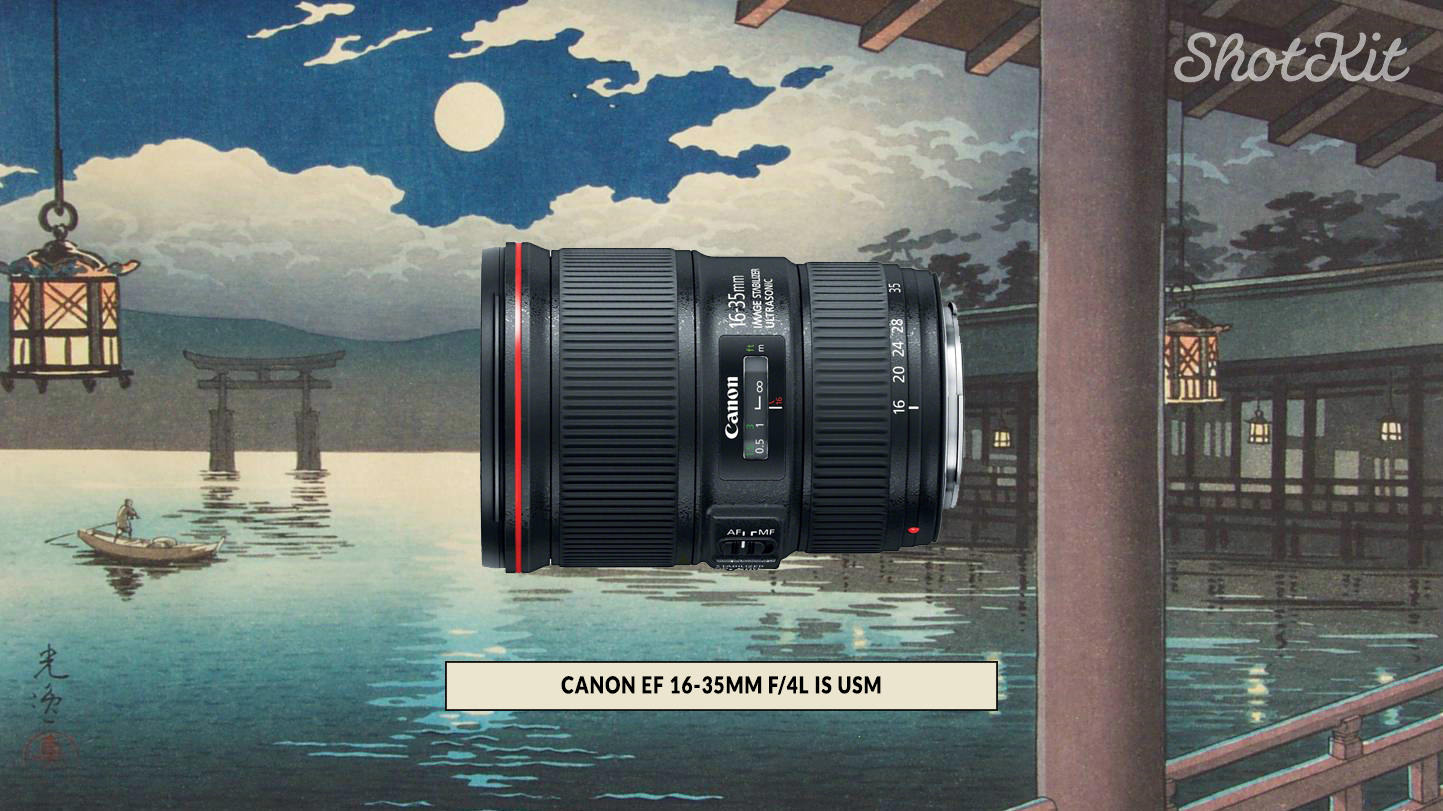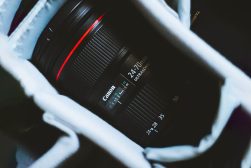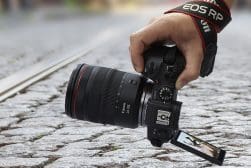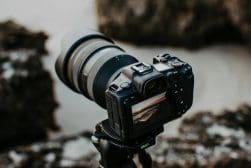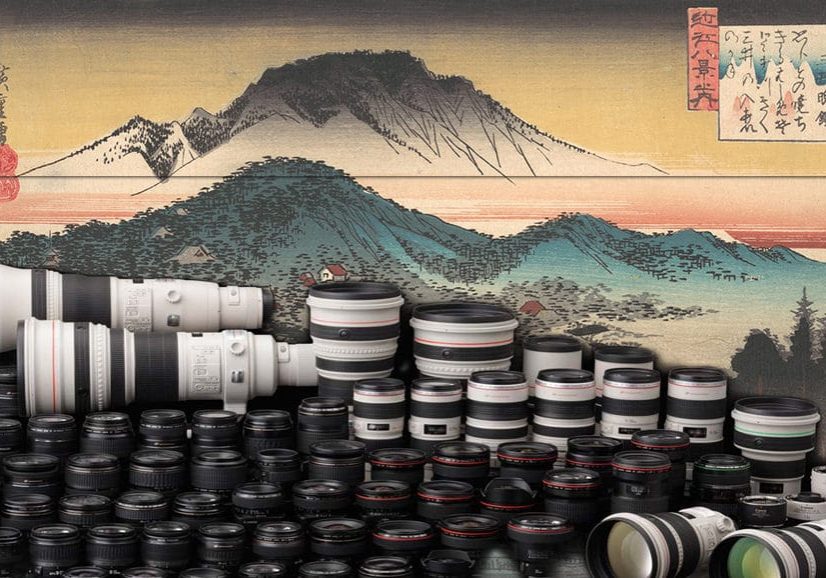
10 Best Canon Lenses in 2024 (EF Mount DSLR)
Choosing the best Canon EF lenses from the huge selection available for the DSLRs wasn't easy, but here are our top 10 picks for all photography skill levels.
Camera Gear Guides | Canon Lens Guides | Lens Guides | By Zach Carrodus | Last Updated: April 4, 2024
Writing a post about the best Canon lenses suitable for most photographers was never going to be an easy task.
Canon has always been a step ahead of its competitors when it comes to offering a wide selection of world-class glass.
At A Glance: Our Top 5 Picks for Best Canon Lenses
From the unmistakable white-barrelled L-series zoom lenses side-lining sporting events around the world to wide-angle zooms on every famous YouTube vlogger’s cameras, Canon lenses are literally everywhere.
To make matters worse for its competitors, Canon’s best lenses are often available for cheaper than their counterparts, sometimes by as much as a few hundred dollars.
In this lens comparison, I’ve included Canon crop sensor (EF-S) and full-frame (EF) options, as well as excellent 3rd party lenses compatible with the Canon mount.
So if you own a Canon camera, read on!
What Are The Best Canon Lenses in 2024?
If you’re considering adding a new lens to your kit, the Canon Lens Comparison Chart below will give you a quick look into the best features and strengths of the top-rated Canon lenses.
| Image | Product | Features | |
|---|---|---|---|
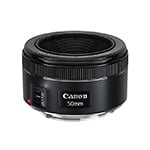 | Canon 50mm f/1.8BEST VALUE PRIME (EF or EF-S) |
| View Price → |
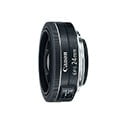 | Canon EF-S 24mm f/2.8BEST VALUE PRIME (EF-S) |
| View Price → |
 | Canon EF 35mm f/1.4 IIBEST ALL ROUND PRIME (EF or EF-S) |
| View Price → |
 | Sigma 30mm f/1.4BEST ALL ROUND PRIME (EF-S) |
| View Price → |
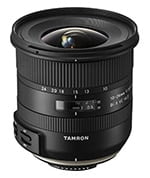 | Tamron 10-24mm f/3.5-4.5BEST VALUE WIDE ANGLE ZOOM (EF-S) |
| View Price → |
 | Canon EF 24-70mm f/2.8 IIBEST MID-RANGE ZOOM (EF or EF-S) |
| View Price → |
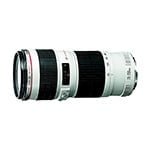 | Canon EF 70-200mm f/4BEST VALUE LONG RANGE ZOOM (EF or EF-S) |
| View Price → |
 | Canon EF 24-105mm f/4 IIBEST ALL PURPOSE ZOOM (EF or EF-S) |
| View Price → |
 | Canon EF 40mm f/2.8BEST FOR TRAVEL (EF or EF-S) |
| View Price → |
 | Canon EF 85mm f/1.8BEST FOR PORTRAIT (EF or EF-S) |
| View Price → |
Think of this review as something you could give to any Canon camera owner and say with confidence, “Pick a lens from this list and you’ll be happy!”
Whether you’re a starter photographer or a seasoned pro, finding the right lens is essential for expressing your creative vision.
In this guide, you’ll find both the best Canon lenses for beginners and professional-grade Canon EF lenses for experienced photographers.
Canon makes various types of camera lenses. Make sure you check if the lenses are EF-S or EF – the EF lenses can all be used on an EF-S camera body, but not the other way around.
So what are the best Canon lenses right now?
1. Canon EF 50mm f/1.8 STM | Best Value Canon Prime Lens
- Compatible Format: EF, EF-S
- Diaphragm Blades: 7
- Minimum Focus Distance: 1.15 ft. (35 cm)
- Filter Size: 49mm
- Dimensions (Diameter x Length): 2.7 in. (69mm) x 1.5 in. (39mm)
- Weight: 0.35 lbs. (158 g)
Just like on the best Nikon lenses post I published recently, this ‘nifty-fifty’ from Canon is the first out the gate in this list (If you’re a Fuji shooter, be sure to check out the best Fuji lenses too).
Spoiler alert: I’m not going to recommend the other 50mm lens that practically every Canon shooter on Shotkit owns, i.e. the Canon 50mm f/1.2L. Even though the f/1.2L is an incredible lens, it’s a bit too specialist for this roundup.
f/1.2 can be useful, but for the majority of applications, the depth of field is just too shallow. Sorry, Canon wedding photographers!
I’d also recommend this lens over the now discontinued 50mm f/1.8 II version, since it’s faster to focus and has 2 extra diaphragm blades, meaning smoother bokeh.
OK, with that out of the way, what makes the Canon EF 50mm f/1.8 STM worthy of a spot here? Why does it have over 600 positive reviews on Amazon, and why is it Canon’s number one best-selling lens?
The first big reason is the price. Or rather, the value for money.
There are cheap Canon lenses, and these are ones that are cheap and awesome too! The Canon EF 50mm f/1.8 STM is in the latter category, exhibiting stellar image quality whilst being the cheapest Canon EF lens ever made!

Canon EF 50mm f/1.8 STM | © Mark Velasquez
For around a hundred bucks, you’re getting a lens that works perfectly with every Canon EOS camera ever made, i.e. every Canon DSLR and every Canon autofocus 35mm film camera made since 1987.
It’s one of the best starter lenses for Canon cameras.
50mm is a favourite focal length of everyone from portrait photographers all the way through to landscape photographers (that’s right – landscapes aren’t just about wide-angle lenses.
Having a wide-angle lens that’s this light and fast to acquire focus is just a joy to use.
On a cropped sensor Canon (EF-S), 50mm translates to around 80mm, meaning the Canon EF 50mm f/1.8 STM becomes one of the top Canon lenses for portrait photography, at least at this price point.
(For this reason, it’s one of the best lenses for Canon 80D.)
If you can stand back far enough to fit your subject in the frame, 80mm can be equally used for any genre of photography of course.
The ‘STM’ in the name refers to Canon’s Stepper Motor technology, which provides a quieter and smoother focus system. Whilst it’s nice to have virtually silent operation for stills-photography, STM is more beneficial for video recording.
Auto-focus is fast and accurate, as is typical with lightweight Canon lenses. Compare this to the f/1.4, and to a greater extent the f/1.2 lenses and you’ll see a huge difference in AF capabilities.
f/1.8 allows enough light into the camera for low-light photography, and if you’ve got a Canon DSLR with high ISO capabilities, f/1.8 will be more than enough for most situations.
It’s only wedding photographers or those who shoot professionally in very dark locations who really have any need for wider apertures than this.
The size of the aperture isn’t just about low light though, of course – larger apertures can also produce more exaggerated bokeh.

Canon EF 50mm f/1.8 STM | © Mark Velasquez
The bokeh from the Canon EF 50mm f/1.8 STM when compared to the f/1.2 version is admittedly less creamy (when both are shot at f/1.8), but it’s doubtful that anyone will notice.
There’s no cheaper way to get a nicely blurred background with sharp foreground than the dinky little Canon 50mm f/1.8 lens.
An additional bonus with the Canon EF 50mm f/1.8 STM is that it can focus closer than any other non-macro Canon 50mm lens, at just 1.15 ft. (35 cm) away from the image plane.
Since this lens is incredibly sharp, you can use a relatively high mega-pixel Canon dSLR (i.e. pretty much any modern one) to crop into the image and still retain this impressive sharpness.
At this price point, you can’t expect a bomb-proof build, but at least the plastic housing feels solid enough to take a few knocks.
The Canon EF 50mm f/1.8 STM is a lens that’s small and light enough that you can do what a lot of photojournalists do and keep it in a jacket pocket to be used when the light drops.
At this price point, it’s also a perfect backup lens for anyone using Canon to shoot professionally. 100-ish bucks could be the most important insurance you ever get!
2. Canon EF 40mm f/2.8 STM | Compact Canon DSLR Lenses
- Compatible Format: EF, EF-S
- Diaphragm Blades: 7
- Minimum Focus Distance: 0.9 ft. (30 cm)
- Filter Size: 52 mm
- Dimensions (Diameter x Length): 2.7 in. (68 mm) x 0.9 in. (23 mm)
- Weight: 0.29 lbs. (132 g)
This is a gem of a lens and makes me envious that there’s no Nikon equivalent. It’s without a doubt a great lens for travel – if you have no need to zoom, I’d actually name it Canon’s top lens for travel.
At less than an inch tall, the Canon EF 40mm f/2.8 STM looks like an overweight lens cap. It’s known as a ‘pancake’ lens for this very reason, and is the smallest of all Canon camera lenses I’ve tested.
Attaching it to the front of your Canon DSLR will bring a smile to your face – at only 0.29 lbs. (132 g), you’ll notice no difference in weight to just your camera body on its own! Canon EF mount lenses don’t come much smaller and lighter than this.
Despite its small size, the Canon EF 40mm f/2.8 STM features impressive optics which render mind-blowing sharpness, edge-to-edge, even wide open.

Canon 40mm f/2.8 STM | © Dylan M. Howell
40mm may seem like an unusual focal length if you’re used to shooting zooms, or at least ‘standard’ focal length primes. However, once you get used to it, it’s actually a remarkably versatile focal length on a full frame Canon camera.
It may sound obvious but 40mm is perfect if you find 50mm too long and 35mm too wide. It’s actually a ‘normal’ focal length.
Personally, I find 50mm too long for the majority of my wedding photography work, so choose to stick with a Nikon 35mm lens.
However, I often struggle indoors with 35mm being just that little bit too wide, including more of the surroundings than I’d like.
As I said before, I’m rather envious of Canon shooters for this lens…!
STM is Canon’s near-silent motor mechanism. It’s not 100% silent on the Canon EF 40mm f/2.8 STM, but for stills photography, it’s as quiet as it needs to be.
There’s only very slight distortion and no chromatic aberration that you’ll notice, but you’ll see some vignetting when shot wide open at f/2.8. Personally, I like a bit of ‘in-camera’ vignette, but if you don’t, it only takes one click in Lightroom to fix it.
Despite its small size, the Canon EF 40mm f/2.8 STM still manages to pack in 7 diaphragm blades, which result in surpisingly smooth and creamy bokeh. Many users actually find the bokeh more pleasing at f/2.8 than even the f/1.8 range of Canon lenses.
Is f/2.8 fast enough for professional use? Well, it depends on how dark the location and how well your camera can handle high ISOs.
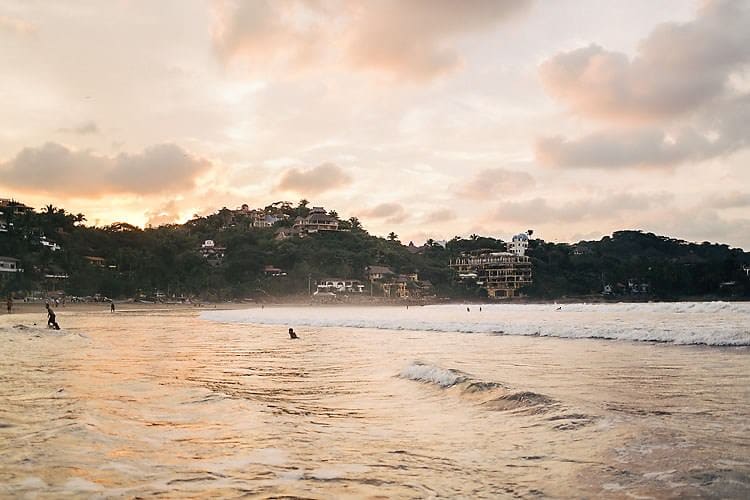
Canon 40mm f/2.8 STM | © Dylan M. Howell
Most wedding photographers would turn their nose up at an f/2.8 prime, despite the fact that their zooms are usually f/2.8 too!
However, I’m willing to guess that for travel photography, even the wedding photogs have a Canon EF 40mm f/2.8 STM stashed somewhere in their backpack.
For this bargain price, there simply isn’t a lighter, smaller and sharper Canon lens in existence.
If you have a big DSLR but still want to remain relatively inconspicuous whilst traveling, I couldn’t recommend the Canon EF 40mm f/2.8 STM more.
You can take this lens out on a family outing or an outdoor portrait photoshoot, rarely missing another focal length in such situations. Rather, you’ll find it’s one of the best Canon lenses for outdoor photography.
Getting a tired wrist after shooting a long day is largely due to the weight of the lens rather than the weight of the camera. It’s the lens that tips the camera off balance, requiring your grip and wrist to counteract the tilt.
With the Canon EF 40mm f/2.8 STM attached to the front of your bulky dSLR, shooting an entire day is a breeze. Did I mention I was really jealous of Canon shooters for this lens?!
3. Canon EF 24-105mm f/4 L IS USM | Most Versatile Camera Lenses for Canon
- Compatible Format: EF, EF-S
- Diaphragm Blades: 8
- Minimum Focus Distance: 1.5 ft. (45 cm)
- Filter Size: 77mm
- Dimensions (Diameter x Length): 4.2 in. (106mm) x 3.3 in. (83mm)
- Weight: 1.5 lbs. (680 g)
Yes, that’s right, I’m recommending the older Canon EF 24-105mm f/4 L IS USM as opposed to the newer v.II of this lens.
This one is 100g lighter than its successor, smaller and cheaper too. The new version has better image stabilization, but I’d still go with this older version every time.
The advantage of this lens is the super-useful focal range that makes it the best overall Canon lens.
It’s also among the most in-demand aftermarket lenses for Canon.
24-105mm is another focal range that Nikon doesn’t offer. Sigma has tried to fill the gap, but it falls short of this Canon version.
The Canon EF 24-105mm f/4 L IS USM is Canon’s highest-performance mid-range zoom available, and even at f/4, deserves its place on this roundup.
Why do I specify ‘f/4’? Well if you’re a professional who needs lenses to work in near pitch-black situations, f/4 just ain’t gonna cut it, even with that excellent image stabilization.
However, for the rest of us (i.e. the majority of Canon owners), f/4 is perfectly fine for our needs.
What’s a USM lens? Don’t even worry about that. It’s Canon marketing speak for ‘relatively silent lens’ :p
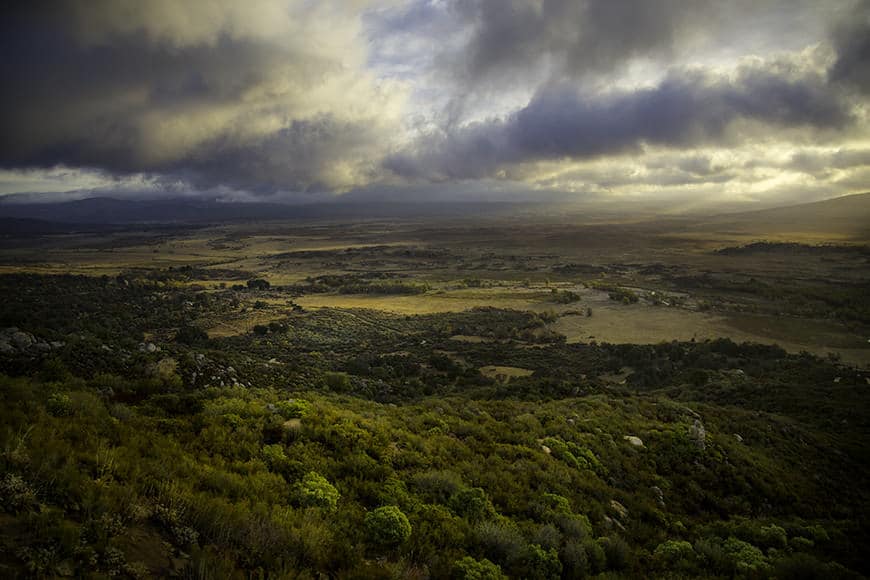
Canon 24-105mm f/4 | © Don Giannatti
As for image quality, the Canon EF 24-105mm f/4 L IS USM has great optical performance throughout its focal range.
Speaking of the range, 24-105mm really covers a lot of options and puts it in the superzoom lens category. I mean, 24-70mm is already great, but having that extra length really makes this Canon zoom lens incredibly versatile.
You can shoot anything from sweeping landscapes, and architecture to zoomed-in wildlife and portraits, which makes 24-105mm the best zoom lens for Canon camera owners.
If you use on-camera flash a lot, the 24-105mm zoom range actually matches the zoom range in E-TTL mode, meaning that the flash zooms to match the lens.
Where it does slip up a little is in the distortion stakes. Whilst a 24-70mm Canon lens has slight distortion, this one is really noticeable at 24mm.
However, one click in Lightroom and it’s all gone. You can even set up an import present in Lightroom to fix distortion automatically, so it’s really not an issue.
There’s also vignetting when shot wide open, but that’s easily correctable in post too.
The Canon EF 24-105mm f/4 L IS USM is impressively sharp for a zoom lens of this range. It’s not quite as sharp as the 70-200mm f/2.8L, but it’s better value, lighter and offers a much more flexible zoom range.
As for the build, it’s top quality. Any ‘L’ series Canon lens is built like a tank, and this one is no different.
The zoom and focus rings are both silky smooth. All L lenses also produce great colours and contrast thanks to the high quality optics, and the Canon EF 24-105mm f/4 L IS USM is no different.
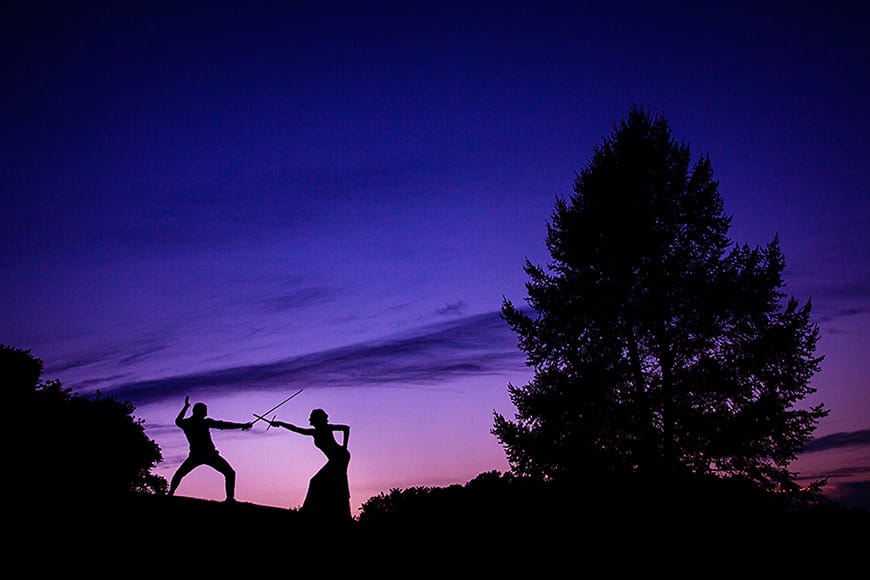
Canon 24-105mm f/4 | © Todd Laffler
As for the image stabilization, it’ll steady camera shake at up to 3 stops.
If you’ve ever used an IS Canon lens before, you’ll know it’s a bit of an eerie experience… What magic is this that steadies the image I see before me?!
Most photographers assume that image stabilization is most useful during low light, but this is only half the story. IS is also beneficial when you shoot at longer focal lengths since camera shake is more pronounced.
When the sun starts to fall and you want to be using lower ISOs, the IS is of course useful throughout the 24-105mm range, but you’ll enjoy it most when shooting at 105mm for a sharp shot.
If you’re a zoom lens shooter looking for a single lens to attach to your camera for good, the Canon EF 24-105mm f/4 L IS USM is the best multipurpose Canon lens for you.
It offers a hugely versatile focal range at a manageable weight, for an affordable price – especially when you consider it as the only lens some people will ever need.
4. Canon 35mm f/1.4 L | Best Canon EF Lenses for Wedding Photography
- Compatible Format: EF, EF-S
- Diaphragm Blades: 8
- Minimum Focus Distance: 1 ft. (30 cm)
- Filter Size: 72mm
- Dimensions (Diameter x Length): 3.1 in. (78.7mm) x 3.4 in. (86.3mm)
- Weight: 20.5 oz. (581 g)
With modern technology, it’s commonly assumed that newer always means better. I know many photographers who’ll rush out to buy the new version of a camera or a lens, despite never having used it before.
That’s what happened when Canon released the v.II of its hugely popular Canon 35mm f/1.4 L – one of the best Canon lenses for wedding photography.
Then people realised their mistake, and with their tail between their legs, returned to the trusty older versions.
Don’t get me wrong – the Canon 35mm f/1.4L II is an amazing lens. When shot wide open, the quality is better than the original version, but it’s only if you’re really examining two photos shot with both lenses side by side that you may notice the differences.
Aside from DxO Mark naming the VII the sharpest Canon lens, and the marginal advantage when shot at f/1.4, I’d still recommend you save some money and go with the original version. Newer doesn’t necessarily mean better. Nor does ‘more expensive’…
There are a lots of sites which discuss why this 1998 lens is actually better than the 2015 one, so I won’t go into it here. However, what I will say is that if you’re lucky, you can still get a new or used Canon 35mm f/1.4 L for a bargain price.
What’s that? $1,200 doesn’t sound very bargain to you?! Try comparing it to the Nikon version! The image quality is indistinguishable and yet the Canon 35mm f/1.4 L comes in at over $400 cheaper!
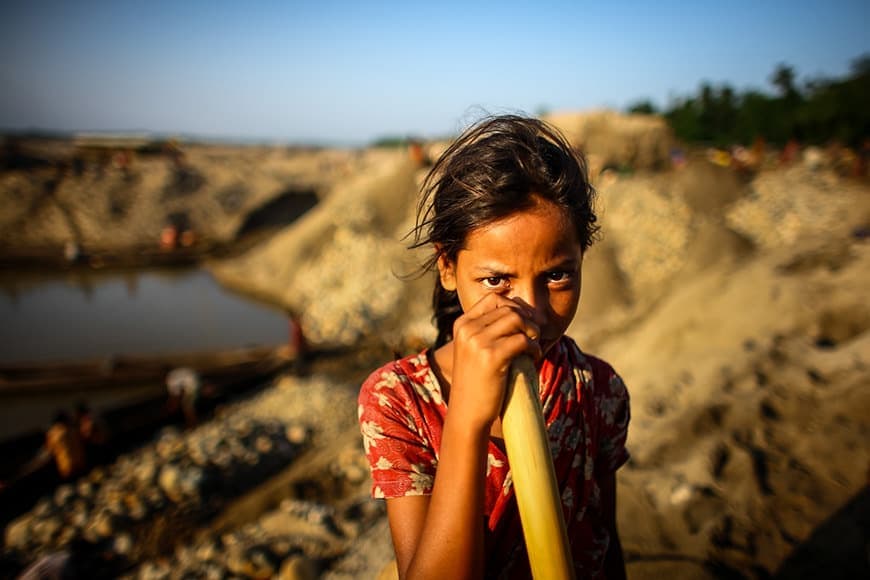
Canon 35mm f/1.4L | © GMB Akash
If you didn’t already know, the 35mm focal length is a favourite of photographers of all genres. Wide enough to ‘fit the whole story in’, whilst still allowing you to take a flattering portrait – just don’t stand too close to your subject.
I use a 35mm lens for 80% of my wedding photography work. If I could get physically close enough to my subjects for the entire day, I’d use it for 100% of it.
This is the lowest aperture lens on the list which makes it probably the best lens for dark conditions.
On a crop sensor Canon dSLR such as the Rebel T7 or T6, 35mm translates to roughly 56mm, which is also a versatile focal length.
However, it’s on a full frame Canon that the Canon 35mm f/1.4 L really sings. Being able to take advantage of the width of 35mm whilst still being able to knock the background into creamy out-of-focus really is useful.
At f/1.4, the Canon 35mm f/1.4 L is super sharp and exhibits beautiful bokeh. Add these two elements together, and shooting a subject a few feet in front of a background at f/1.4 delivers an almost 3D effect – the subject is pin sharp, whilst the background is a sea of beautifully blurred colours.
Another bonus is that being a USM lens, you can grab the focus ring of the Canon 35mm f/1.4 L and adjust it manually to override the auto-focus.
This is really useful for wedding photographers who need to focus on the bride’s eye and not the veil during a close up portrait, for example.

Canon 35mm f/1.4L | © Robert J Hill
There’s no need to mention colour, contrast or build quality – it’s a Canon L series lens. Nuff said.
What’s most impressive about the Canon 35mm f/1.4 L for a Nikon shooter like me (aside from its price!), is the fact that it exhibits very little distortion – way less than the Nikon 35mm equivalent.
As for the sharpness, Ken Rockwell said:
The Canon 35mm f/1.4 L is among the sharpest wide lenses I’ve ever tested. It is extraordinarily sharp and contrasty, even at f/1.4.
It truly is remarkable that a lens that’s over 19 years old can out-perform much more recent ones. I can’t really understand why Canon chose to update the Canon 35mm f/1.4 L – it really is that good.
If you’re a Canon full frame dSLR camera owner who wants one prime lens to be used during the day, during the night, for wide shots and for portraits, there simply isn’t anything better.
If I were a Canon shooter, the Canon 35mm f/1.4 L would definitely be the first lens I bought.
5. Canon EF 85mm f/1.8 USM | Best EF Lenses for Portrait Photography
- Compatible Format: EF, EF-S
- Diaphragm Blades: 8
- Minimum Focus Distance: 2.8 ft. (85 cm)
- Filter Size: 58 mm
- Dimensions (Diameter x Length): 2.95 in. (75 mm) x 2.83 in. (72 mm)
- Weight: 0.94 lbs. (426 g)
I’m fully aware that Canon f/1.2 owners will stop reading right about now. They may even spit at the screen…
There’s even a f/1.4 version of this 85mm (here), but I still stick by this humble f/1.8 version…
Let’s deal with the elephant in the room first. Why oh why would I not recommend the Canon 85mm f/1.2L II?! A lens that’s widely regarded as one of the greatest portrait lenses ever created.
One word. SLOW. And if you needed 3 more, HUGE, HEAVY and EXPENSIVE!
If you shoot models in a studio all day long, then fair enough. Maybe you don’t need a lightweight lens with fast auto focus (you probably don’t need f/1.2 either, but that’s another story).
However, to all those wedding photographers who insist on using the Canon 85mm f/1.2L lens in low light during the reception, I’ll put money on at least 50% of your shots being missed.
So, onto the Canon EF 85mm f/1.8 USM – what makes this little-known lens such an incredible bargain?
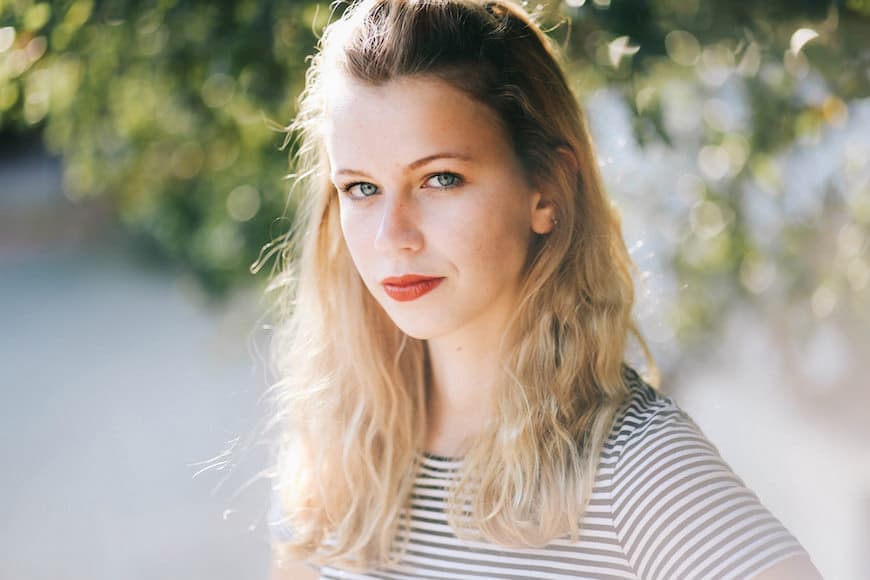
Canon EF 85mm f/1.8 USM | © Diane Villadsen
For just under $350, you’re getting a ridiculously good portrait lens with un-rivalled sharpness, at half the price of the Nikon equivalent!! Damn you, Canon!
As another kick in the balls to Nikon users, this Canon version features manual focus override, meaning you can grab the focus ring to make manual adjustments, even in auto-focus.
This is a hugely underrated advantage, as any Nikon user who’s had to take their eyes off the action to fiddle with a manual focus switch will tell you.
85mm is a popular focal length for portrait photographers, or for those who want to get closer to the action without moving their feet!
85mm still retains the feeling of being ‘involved‘ in the image, rather than longer focal lengths that make the viewer more of a spectator.
If you’ve got room to move back, 85mm is also a great focal length to shoot group portraits. Just make sure to stop down so each row of the group is in focus, but 85mm can be a flattering and efficient way to knock the background out of focus.
On a cropped sensor Canon dSLR, 85mm translates to around 136mm – no longer a versatile focal length perhaps, but still excellent for portraits.
At this price point, buying this EF lens to be used on your EF-S camera body still makes perfect sense.
The bokeh when the Canon EF 85mm f/1.8 USM is shot at f/1.8 is gorgeous. Sure, the f/1.2 can reduce any background to cream, but when shot at f/1.8, only a pixel peeper could tell the difference between other Canon EF mount lenses.
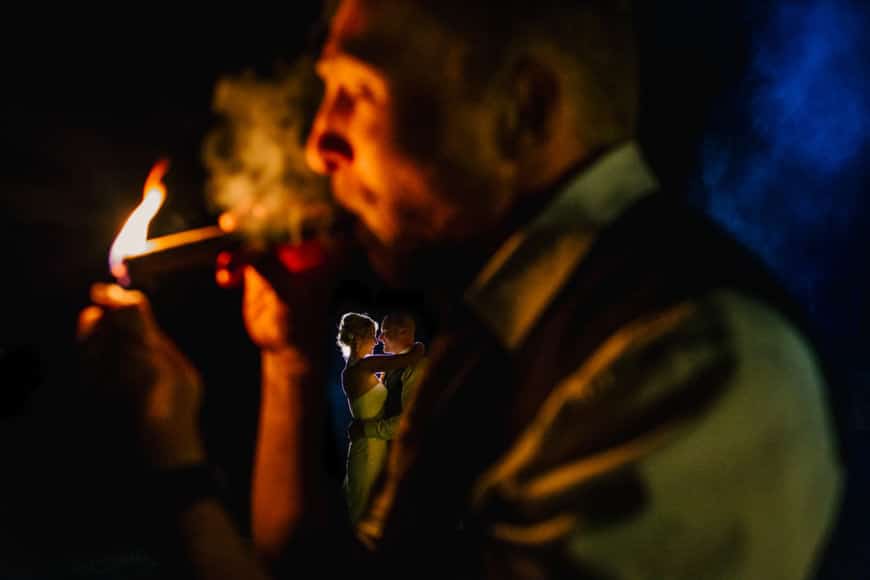
Canon 85mm f/1.8 | © Stark Photography
It’s also very refreshing to be able to shoot at this focal range with such a (relatively speaking) lightweight lens. The build is plastic, but strong enough to withstand knocks.
Focus speed is great. Comparing it to the f/1.2 is like comparing a gun to a bow and arrow – Canon prime lenses don’t focus much quicker than this.
If you haven’t got the time to wait for the lens to do its thing, the Canon EF 85mm f/1.8 USM wins every time.
Just because the Canon EF 85mm f/1.8 USM doesn’t have that elusive red ring of the L series Canon lenses, doesn’t mean it can’t trade punches with the big boys.
This really is a bargain of a lens, and one of the big reasons I’d recommend a newcomer to wedding photography with a modest budget to use Canon over Nikon.
Lenses really are cheaper on the Canon side of the fence, and the Canon EF 85mm f/1.8 USM performs like a lens 3x the price.
6. Canon EF 24-70mm f/2.8 L II | Canon EF Zoom Lenses with Versatile Focal Range
- Compatible Format: EF, EF-S
- Diaphragm Blades: 9
- Minimum Focus Distance: 1.25 ft. (38 cm)
- Filter Size: 82 mm
- Dimensions (Diameter x Length): 3.5 in. (88 mm) x 4.4 in. (113 mm)
- Weight: 1.7 lbs. (805 g)
It’s time to bring out the big guns. No more pussy-footing around with old lenses or first versions – the Canon EF 24-70mm f/2.8 L II is quite simply the top all-round Canon zoom lens money can buy.
The first version of this hugely popular lens was good, but this second iteration is way better. Even though it’s almost twice the price, it’s definitely justified.
The Canon EF 24-70mm f/2.8 L II is among Canon’s most popular pro lenses ever and is a favourite for both amateur and professional Canon dSLR camera owners the world over.
There’s an f/4 version too, but the Canon EF 24-70mm f/2.8 L II is much better. It’s also even sharper than the Nikon equivalent.
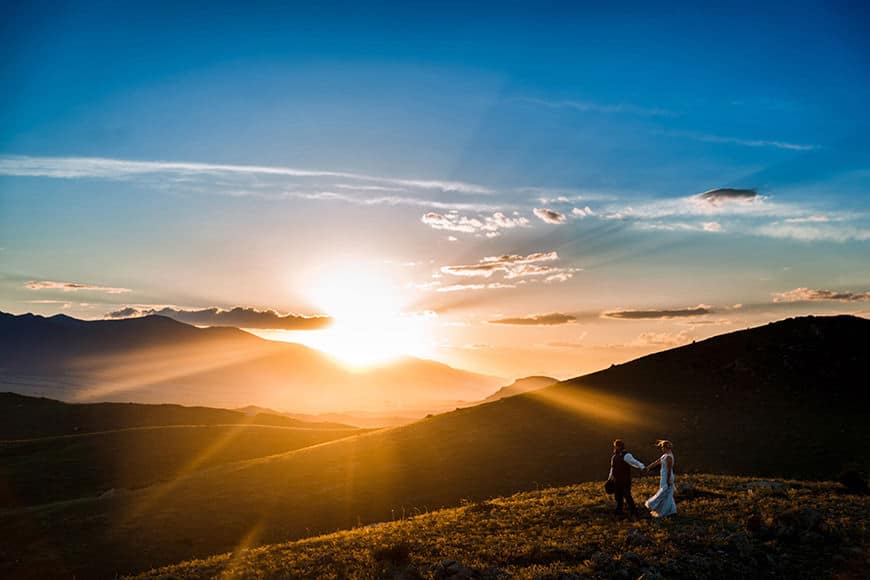
Canon 24-70mm f/2.8 L II | © Gillespie Photography
The 24-70mm focal range is extremely popular with professional wedding and event photographers who need to quickly move from wide groups to close up detail, all in one twist of a lens barrel.
Common pro usage of the Canon EF 24-70mm f/2.8 L II is to use the wider zoom range for a large group portrait, then to switch to 70mm to isolate one of the subject’s reactions within the group.
This is much harder when using 2 prime lenses on 2 bodies, as I can attest!
The Canon EF 24-70mm f/2.8 L II is also commonly used on the dance-floor at wedding receptions. It’s definitely not a light lens to be used at the tail end of a long day, but the versatility in the zoom range, coupled with its incredible autofocus performance really is undeniable.
The AF is fast and accurate, even at f/2.8. Let’s face it, no one buys an f/2.8 lens to shoot at anything but wide open.
The beauty of f/2.8 is that you can pretty much get away with shooting it wide open all day long.
With the primes, you’ll be struggling with f/1.2 and f/1.4 on a sunny day, but with the Canon EF 24-70mm f/2.8 L II, blown-out photos are one less thing to worry about if shooting in aperture priority.
The versatile zoom range makes it the best lens choice for all kinds of photoshoots- portraits, fashion, or weddings -outdoors or indoors.
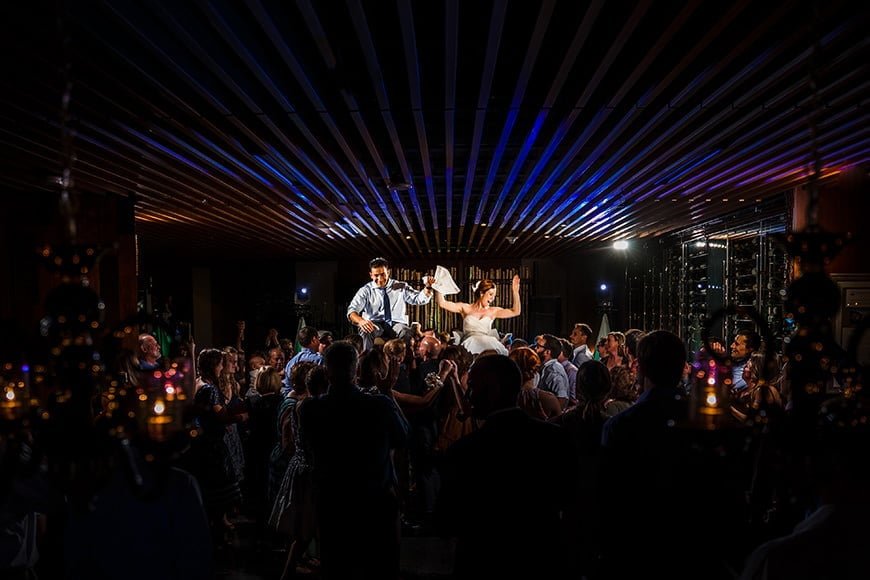
Canon 24-70mm f/2.8L II | © Gillespie Photography
On the downside, f/2.8 doesn’t really give you much subject separation unless you shoot it at around 70mm. That’s why I wouldn’t call a 24-70mm one of the top lenses for portraits – moreover, it’s a hugely versatile story-telling lens.
From 24-70mm, you won’t be missing any of the action, and when you have a chance to use 70mm, you can still benefit from bokeh to make your subject stand out from the background.
In summary, the Canon EF 24-70mm f/2.8 L II is one of the sharpest lenses I’ve ever used. 24-70 is a great focal range, and even at 38-115mm on a cropped sensor camera, it’s a very useful lens that can remain on your camera all day long.
It’s without a doubt the best zoom lens for wedding photographers.
If you’ve got around $2k to spend on lenses, I’d recommend this one every time. With your change, get the 50mm f/1.8 from above, and you’ll be able to shoot anything, anytime.
7. Canon EF 135mm f/2L USM | Best Telephoto Lens for Canon Shooters
- Compatible Format: EF, EF-S
- Diaphragm Blades: 8
- Minimum Focus Distance: 3 ft. (91 cm)
- Filter Size: 72 mm
- Dimensions (Diameter x Length): 3.27 in. (83 mm) x 4.41 in. (112 mm)
- Weight: 1.7 lbs. (771 g)
If there’s one Canon telephoto lens that makes Nikon shooters jump ship to Canon, the incredible Canon EF 135mm f/2L USM is it.
Ask any one of the photographers on Shotkit who own this lens and they’ll tell you that it’s simply one of the most incredible portrait lenses of all time.
Nikon has a 135mm lens, but it just can’t compete with this. The Canon EF 135mm f/2L USM hasn’t been updated since 1996, but why should it? If it ain’t broke, don’t fix it.
Optically, the Canon EF 135mm f/2L USM is very impressive. Colours and contrast are excellent as with all Canon L series lenses, and bokeh when shot wide open makes backgrounds melt away in a creamy swirl of colours.
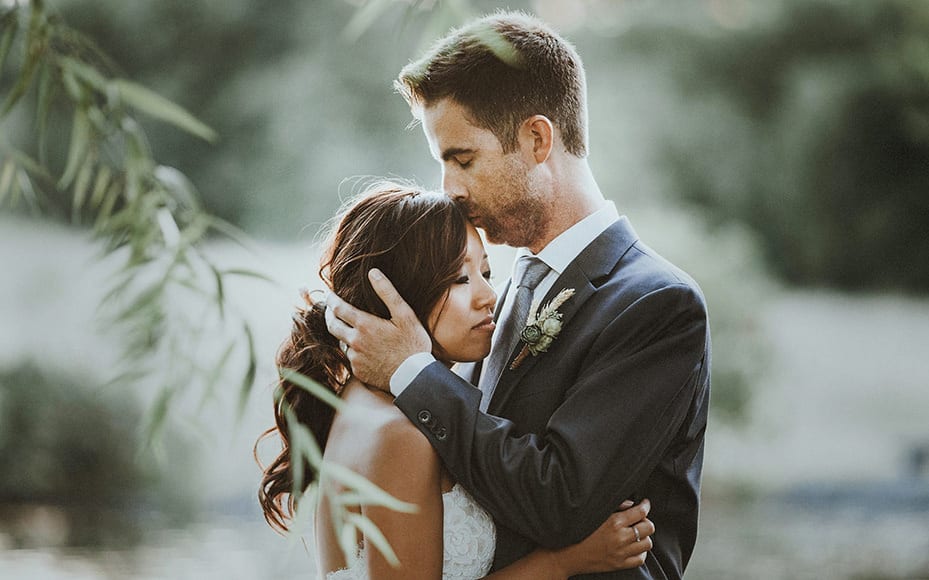
Canon 135mm f/2 | © Jay Cassario
If you’re a pixel peeper, you’ll note that the 8 diaphragm blades produce a beautiful circular bokeh, especially at f/2. Even if you don’t notice, it’s hard to deny that a photo shot with the Canon EF 135mm f/2L USM just looks like no other.
Autofocus is lightning fast and accurate, and ergonomically this lens feels great attached to even the biggest Canon dSLRs.
It’s not a compact or lightweight lens by any means, but its ergonomics and build quality just feel right.
The 135mm focal length isn’t particularly versatile, and for this reason, I did hesitate to include the Canon EF 135mm f/2L USM on this list. Unless you have a subject in the distance or have room to move back, 135mm is too tight for most situations.
However, for wedding or event photographers who need that extra reach, or portrait photographers who want a flattering focal length or the ability to reduce any backgrounds to beautiful blur, there really is no rival to the Canon EF 135mm f/2L USM.
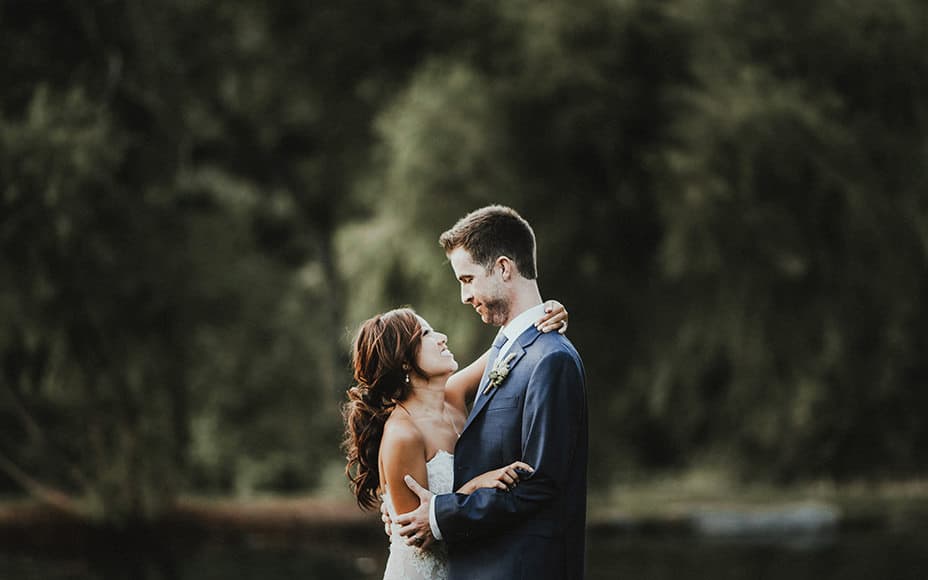
Canon 135mm f/2 | © Jay Cassario
Fixed 135mm Canon lenses are admittedly not suited to all-day use, but it’s something to have in the bag for those special moments that require it.
Many photographers who own the excellent Canon 70-200mm f/2.8L start using the Canon EF 135mm f/2L USM and never go back. Being able to zoom is useful, but the smaller size, weight and larger aperture of the 135 make the 70-200 redundant.
When compared to 85mm, 135mm gives the photographer just enough physical distance from the subject to largely remain unnoticed.
Also, being a relatively small black lens rather than a huge white one means that the Canon EF 135mm f/2L USM is more likely to pass incognito than a larger zoom.
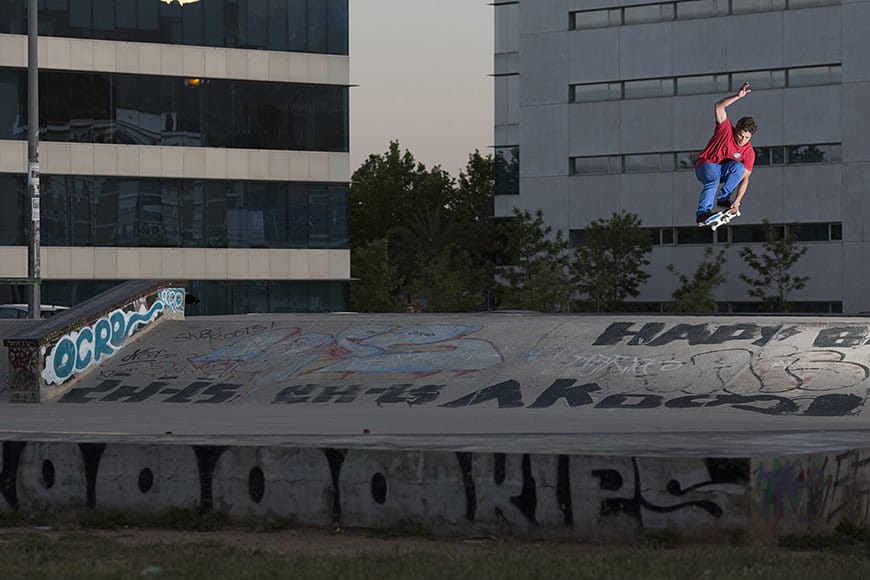
Canon 135mm f/2L USM | © Tono Garcia
More importantly, the look of the images produced by the Canon EF 135mm f/2L USM has a certain quality that other lenses simply can’t reproduce.
It’s one of the top Canon lenses for portraits and is actually great value for money for the kind of image it can produce.
If you’re a bokeh-whore but you budget can’t quite stretch to the f/1.2’s of the Canon lens lineup, the Canon EF 135mm f/2L USM is there for you!
f/2 at 135mm gives incredible subject separation, and as long as you have space between you and the subject, 135mm makes for a very flattering lens for photographing people.
If you want to see more examples of images shot with the Canon EF 135mm f/2L USM, just filter by the lens in the drop-down menu over on the right.
You’ll find that every photographer who owns this Canon long lens has something great to say about it, so maybe it’s time you saw what all the fuss is about too ;-)
8. Canon EF 16-35mm f/4L IS USM | Best Canon Lens for Video (Value for Money)
- Compatible Format: EF, EF-S
- Diaphragm Blades: 9
- Minimum Focus Distance: 0.92 ft. (28 cm)
- Filter Size: 77mm
- Dimensions (Diameter x Length): 3.3 in. (82 mm) x 4.4 in. (112 mm)
- Weight: 1.35 lbs. (615 g)
There are 4 different versions of the 16-35mm zoom in the Canon lens lineup. 3 of those lenses are f/2.8, which is usually considered ‘better’ than f/4. So why on earth have I chosen the Canon EF 16-35mm f/4L IS USM as one of Canon’s top wide-angle lenses?
Let’s get one thing straight from the outset. If you absolutely need the sharpest, fastest (largest aperture, not AF speed) ultra-wide angle lens from Canon, don’t get this lens. The Canon 16-35mm f/2.8L III is better.
However, it’s also bigger, heavier, and much more expensive!
The Canon EF 16-35mm f/4L IS USM on the other hand is sharp enough for most situations, and the image stabilization allows it to be shot handheld as if you had an aperture of f/2.8 anyway.
Don’t think about the difference in f/4 vs f/2.8 from a bokeh-producing standpoint – with an ultra-wide angle lens such as this, it’s very hard to get any kind of blurred background or subject separation whatsoever.
One caveat is that image stabilization doesn’t work as well when the subject is moving. That’s why the majority of photographers who invest in one of the f/2.8 variants of the 16-35mm are event or wedding photographers.
I’d go as far as to say that the f/2.8 III is the best Canon wide-angle lens for weddings, and it’s also super popular for shooting video.
However, if your subject is stationary (hello architecture and landscape photographers!), the IS on the Canon EF 16-35mm f/4L IS USM works great.
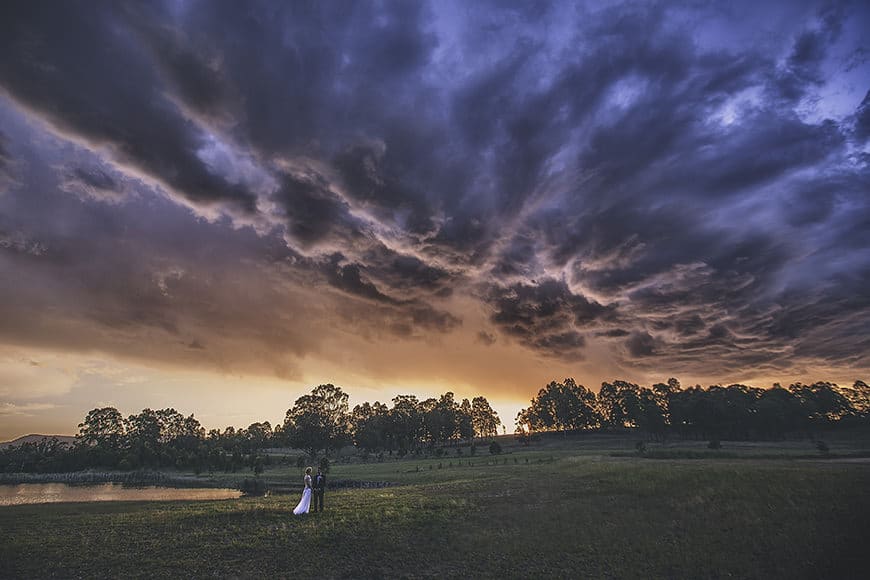
Canon 16-35mm f/4 | © Joseph K. Sarkodie
Even when the light falls, the IS will give you four extra stops… which actually means it’ll fair better than an f/2.8 without the IS.
Shooting at ultra-wide angles already allows you to use much slower shutter speeds when shooting handheld. By using the IS, you can expect sharp shots even as slow as 1/2 second… which is frankly ridiculous.
Another benefit of this lens is that the USM in its name means that you can take advantage of manual focus override – if your camera misses focus for whatever reason, just twist the focus ring to correct it and move on. There are no fiddly switches to waste your time turning on and off, making it perfect for shooting video.
As for the image quality, the red ring of the Canon EF 16-35mm f/4L IS USM indicates that it’s optically superb… and it is.
As with all ultra-wide angle lenses, you can expect moderate barrel distortion at 16mm, but where this lens excels is that there’s very little distortion from 20-35mm in the zoom range.
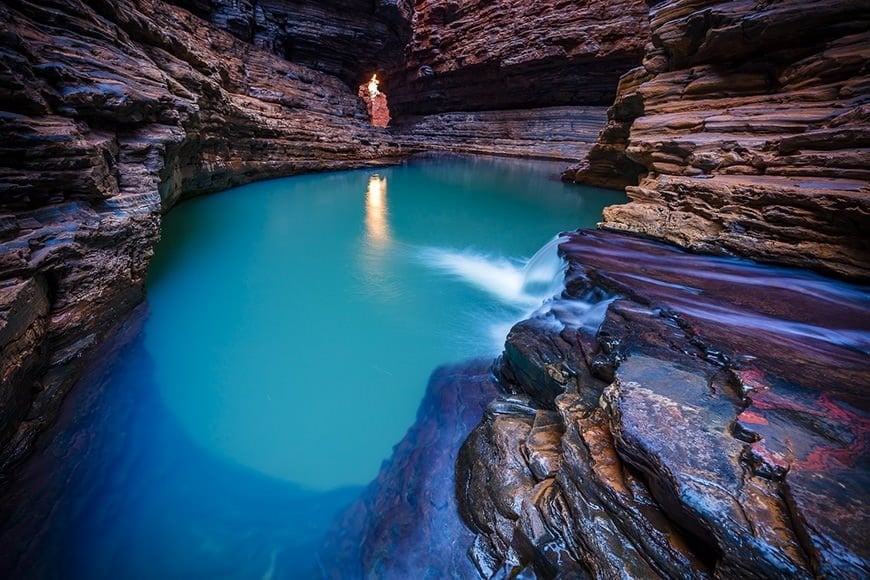
Canon 16-35mm f/4 | © Darran Leal
As with all modern lenses, distortion, vignettes and other known issues are all instantly correctable using Lightroom or any other major editing software. It really isn’t an issue for anyone who edits their photos.
If you’ve never shot at 16mm, prepare to be blown away – it really is an eye-opener… and the Canon 16-35mm f/4 is a great value for money way to experience it.
Whilst this lens can be used on an EF-S mount Canon, the focal range will be longer (narrower). For APS-C (cropped) cameras, I’d recommend the lens coming up next in this list – it’s super wide and cheap too.
So in summary, if you’re an automobile, architecture, landscape or any other genre of photographer who needs the widest of sensible wide-angles, the Canon EF 16-35mm f/4L IS USM is a great value-for-money option for you. If you find these Canon lenses for sale at a reasonable price, grab them!
Don’t get sidetracked by the exotic f/2.8 lenses in this focal range – most photographers don’t need them.
9. Canon EF-S 10-18mm f/4.5-5.6 IS STM | Best Wide Angle Lens for Canon APS-C Cameras

- Compatible Format: EF-S
- Diaphragm Blades: 7
- Minimum Focus Distance: 0.72 ft. (22 cm)
- Filter Size: 67mm
- Dimensions (Diameter x Length): 2.95 in. (74mm) x 2.83 in. (71mm)
- Weight: 0.53 lbs (240 g)
It’s rare to find an ultra-wide angle lens for cropped sensor cameras, since the nature of APS-C is to lengthen focal distances. However, the impressive Canon EF-S 10-18mm f/4.5-5.6 IS STM manages to achieve just this.
In my opinion, it’s the best wide-angle lens for APS-C Canon shooters.
One often unmentioned benefit of shooting with a Canon APS-C body is the relative affordability of lenses. This is obviously apparent if you consider the difference in price between APS-C and full frame Canon bodies in general, but the lower prices of the lenses is another huge benefit.
At less than $300, the Canon EF-S 10-18mm f/4.5-5.6 IS STM delivers enormous bang for the buck. Just check out how sharp and un-distorted the image below is:

Canon EF-S 10-18mm f/4.5-5.6 IS STM | © Jorge Guadalupe Lizárraga
It’s small and super lightweight, especially for a zoom, and is a joy to shoot with. It’s the kind of lens you can have in a jacket pocket while hiking and forget it’s there.
Landscape photographers who are used to big and bulky lenses will rejoice in having this lens permanently attached to their cameras.
The Canon EF-S 10-18mm f/4.5-5.6 IS STM is optically very impressive. There’s no sharper ultra-wide angle lens for APS-C cameras, and it also adds image stabilization (IS) – a first for any Canon ultra-wide.
STM means that focusing is virtually silent, but more importantly, you’re able to grab the focus ring at any time to make minor adjustments to the autofocus.
This is incredibly useful for landscape photographers – using the camera’s Live View to zoom to 100%, you can make micro-adjustments to the focus without needing to flip switches or otherwise disturb the camera.
The image stabilization works great and negates any issues you may have with the relatively slower apertures.
Achieving a shallow depth of field is impossible when using ultra-wide angle lenses, so the only thing apertures governs here is the amount of light entering the camera. The IS allows for an extra 4 stops, meaning the Canon EF-S 10-18mm f/4.5-5.6 IS STM can be shot handheld even at 1/4 or 1/2 a second.
This in turn means you can use much lower ISOs to get the shot, meaning much cleaner images.
For example, check the wide-angle sample picture below which illustrates why this is the best lens for Canon APS-C camera owners who like taking expansive shots which encapsulate the landscape:
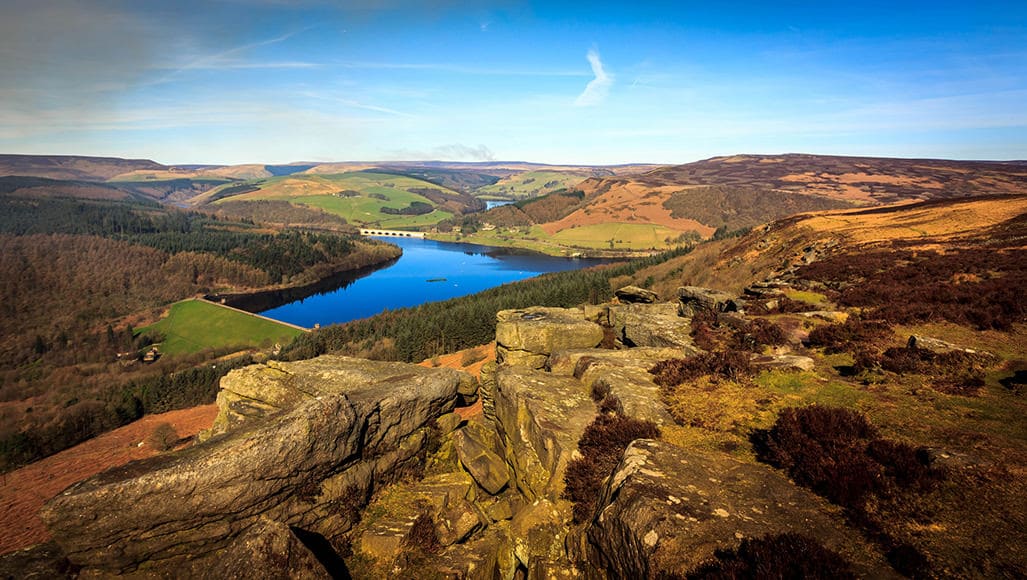
Canon EF-S 10-18mm f/4.5-5.6 IS STM | © Ian Emerson
The sharpness produced by the Canon EF-S 10-18mm f/4.5-5.6 IS STM really is mind-blowing. It’s even sharper than full-frame wide-angle lenses costing 10x the price!
Coupled with the close focusing distance of only 0.72 ft (22 cm), you can crop into an image shot with the Canon EF-S 10-18mm f/4.5-5.6 IS STM and still achieve razor-sharp close-ups.
It’s razor-sharp in fact throughout the entire image at every setting. This is rare for an ultra-wide angle lens, and the fact that it’s all available at a budget price is unbelievable.
To achieve such a low price, lenses need to be made out of plastic. Usually, this means dubious build quality and shorter lifespans, but that’s not the case with the Canon EF-S 10-18mm f/4.5-5.6 IS STM – it’s all plastic, but it still manages to feel great quality, perhaps due to the large rubber focus ring that takes up the majority of the lens barrel.
The size and weight of the Canon EF-S 10-18mm f/4.5-5.6 IS STM really is a huge advantage, and coupled with a lightweight APS-C Canon DSLR, it’s a pleasure to shoot.
It’s without a doubt one of the top Canon lenses for landscape photography and any genre of art that encourages you to fit as much as possible within the frame.
Simply put, the Canon EF-S 10-18mm f/4.5-5.6 IS STM has no competition. Every other ultra-wide angle lens for Canon’s APS-C cameras costs at least twice as much, is optically inferior, can’t focus as close or has no image stabilization.
If you’re about to invest in a crop sensor camera from any brand to be used for landscape photography, this is the kind of lens that makes Canon cameras the number one bet.
10. Canon EF-S 24mm f/2.8
- Compatible Format: EF, EF-S
- Diaphragm Blades: 7
- Minimum Focus Distance: 6 in (0.16 m)
- Filter Size: 52mm
- Dimensions (Diameter x Length): 2.7 in (68.2 mm) x 0.9 in (22.8 mm)
- Weight: 4.4 oz (125 g)
Another cheap and awesome Canon lens, the Canon EF-S 24mm f/2.8 is a traveler’s dream.
It’s tiny! In fact, depending on which APS-C camera you’re shooting with,
The 24mm on a cropped sensor comes out to just about 38 mm equivalent on a full frame and is the perfect focal length for walking around town. wide enough to take in your surroundings but not so wide that you have no emphasis on your subject.
Another cool thing about its size is that it’s quite discreet when looking for candid street photography moments. The 24mm also gives you a bit more space to work with when designing your compositions.
Although not a dedicated Canon macro lens, it actually has great macro capabilities – especially with extension tubes.
But size, price, and versatility are where the EF-S 24mm f/2.8 STM really shines.
As far as focusing is concerned, while not as fast or quiet as some other lenses with the STM (stepper) motor, the autofocus still does an admirable job, even in lower light situations.
The manual focus ring works as smoothly as butter, and the manual-focus system works beautifully. The manual focus override works full-time (even in One Shot AF mode).
The image quality is quite fantastic for a $150 lens. The colors are vivid, the contrast is excellent, and the bokeh is nicely blurred.
It has excellent corner-to-corner sharpness (especially when stopped up just a bit to f/4), , and while there is some vignetting, it doesn’t really get in the way.
As far as focus distance is concerned, this 24mm puts you right where you want to be for general photography –
Surprisingly, the 24mm f/2.8 also comes with specialized coatings on the lens elements to reduce ghosting and flare. Quite the treat at this price.
There is a slight hum when focusing during the video, but for me, it was pretty hard to hear. Still, if you want things totally silent use a shotgun or offboard mic or manual focus (which again, works excellently). (You’ll need Movie Servo for the AF.)
Also, there isn’t any image stabilization, so handheld video work is pretty much out.
While this isn’t a professional lens by any means, it’s really an excellent all-around workhorse that takes up next to no space.
If you’re just jumping up from an 18-55mm kit lens, you’ll definitely appreciate the improved image quality and better low-light performance the 24mm f/2.8 brings.
Add to this that you can buy this little guy for just $130 right now and wow! You really can’t beat the value you’re getting for next to no $$.
In size, price, and value, this pancake lens really takes the cake!
Canon Lens Buyer’s Guide | What Should You Buy First?
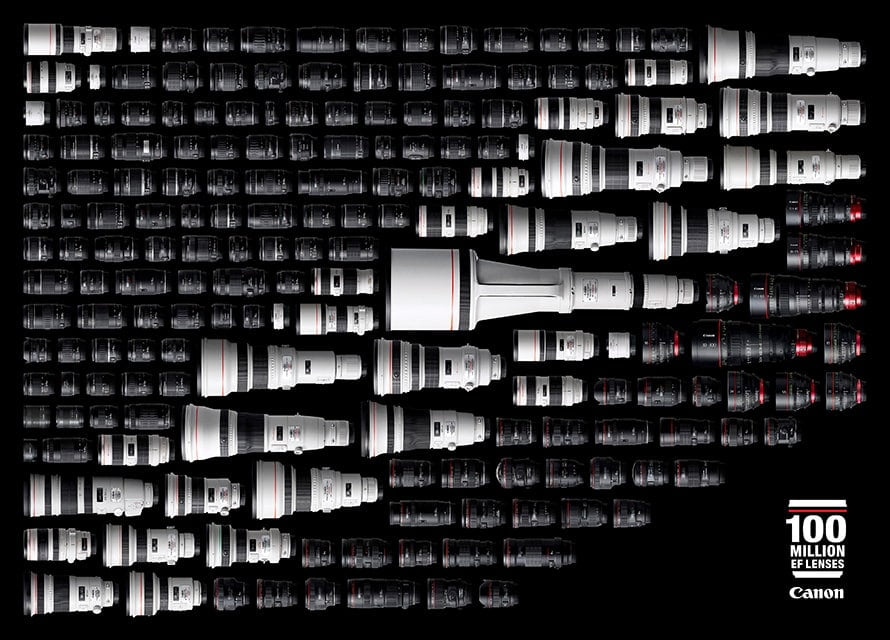
This is a camera lens guide about the top recommended Canon lenses for all-round usage.
It’d be easy for me to just recommend all the most expensive lenses in each category since in some regards they can be considered the ‘best’.
However, this guide is to recommend lenses that offer bang for your buck i.e. the top performance + value for money.
If you want to know what Canon lenses to buy first, this summary should help:
For Canon EF camera owners who want a great all round lens, the Canon 50mm f/1.8 STM is hard to beat. It’s also the cheapest way to get that coveted ‘blurred background’ look.
The 50mm f/1.8 works fine on an EF-S body, but remember that the focal lens becomes 80mm – a little less versatile than 50mm, but still great as a portrait lens. I also recommend it to Canon EF-S camera shooters since you can use it on an EF body if you ever choose to upgrade.
If you want something a little wider, but just as small and light for your EF-S body, the Canon 24mm f/2.8 is a great choice. Equivalent to 38mm on a full frame camera, it’s the perfect everyday walk around lens, or great for travel due to its compactness. The maximum f/2.8 aperture also produces great bokeh, on the cheap!
Once you’ve got your small, lightweight and affordable prime lenses sorted and you want to explore something a little more exotic, I’d recommend investing in some ‘fast’ primes.
For Canon EF cameras, the Canon 35mm f/1.4 II is hard to beat. Sure, Canon’s f/1.2 lenses are awesome, but their size, weight and price make them a little harder to recommend unless you’re a pro.
There are plenty of great f/1.4 Canon lenses, but 35mm is just such a versatile focal length – you can shoot portraits, landscapes and everything in between… and f/1.4 is plenty fast enough for low light situations, and for blurring the background beautifully.
On the crop sensor EF-S bodies, you can’t go wrong with the Sigma 30mm f/1.4 – it’s great value for money, and offers the same image and build quality as Canon lenses twice the price.
Lucky enough to own the Canon EOS R? Any of the recommended EF lenses in this article work well with the EF-EOS R adapter, but it’s the new RF lenses that really make the most of this camera – the Canon RF 50mm f/1.2 and the RF 28-70mm f/2 are the stand-outs, despite being heavy and expensive.
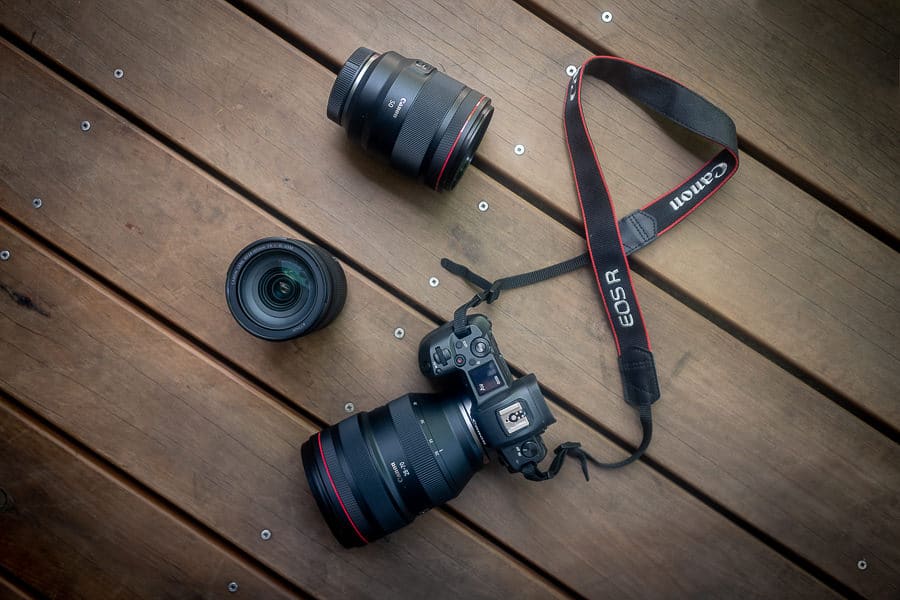
Own the Canon EOS R? The Canon RF 28-70mm f/2 is a heavy brute of a lens but delivers incredible results.
As for zooms, you’re in luck – Canon offers some of the most incredible medium and long-range telephoto lenses money can buy ;-)
If you’re shooting full frame, the Canon 24-70mm f/2.8 II is the cream of the crop, and arguably the only zoom lens you’ll ever need. Yes there’s an f/4 version which is a lot cheaper, but you won’t get much subject separation at the wider ends of the zoom range with this maximum aperture… at least, not like you can with f/2.8.
For a long-range zoom, I do however recommend saving some money on the Canon 70-200m f/4, which is incredible value for money. When shooting at 70mm+, you’ll get great subject separation (and beautiful bokeh) even at f/4.
Sure, f/2.8 offers better low-light performance, but the excellent Image Stabilization of the 70-200m f/4 should still get you out of trouble after dark.
Canon EF-S shooters can still benefit from the two above zooms, especially if you need some extra reach (with the 1.6x crop factor).
However, if it’s a multi-purpose wide-angle EF-S zoom you want, the Tamron 10-24mm f/3.5-4.5 is a great choice and surprisingly affordable.
Finally, for all you Canon crop sensor shooters who want to shoot wildlife, the stars, or anything else that’s far away, the Sigma 150-600mm f/5-6.3 is an extraordinary lens and amazing value for money.
What Do The Letters & Numbers on a Canon Lens Mean?
There are different types of Canon lenses available for APS-C, Full frame and the new mirrorless system. But before you get too bogged down in the Canon lens reviews, it’s important to understand what all the letters in the lens name mean.
You can quickly check your camera’s compatibility with a lens by correctly reading the lens name.
Here’s an example of a lens that’s got quite an extended title:

Canon lens abbreviations can be rather confusing…
The above lens is the Canon EF 70-200mm f/4L IS II USM lens. Let’s take a closer look at the meaning of all these confusing abbreviations:
- EF – these lenses are designed to cover the full 35mm image and are compatible with all Canon EOS cameras
- 70-200mm – the focal range
- f/4 – the maximum aperture
- L – ‘Luxury’, designating Canon’s pro-grade lenses, built to Canon’s highest standards
- IS – Built-in Image Stabilization
- II – the version number
- USM – ‘UltraSonic Motor’ is a fast, quiet and powerful focusing motor that allows manual-override
Other common Canon lens abbreviations include:
- EF-S – lenses designed for APS-C sensor cameras
- EF-M – lenses designed for Canon EOS M mirrorless cameras
- RF – lenses designed for Canon EOS R full-frame mirrorless cameras
- STM – Stepper Motor designed to reduce autofocus vibrations and noise during video recording
In this article, I’ve removed the lettering after the main elements of each lens name to try and keep it a bit more simple ;-)
Canon Lens Sizes Chart
Here’s a table showing the sizes of 12 popular Canon lenses, including their length and diameter:
| Lens Model | Length (mm) | Diameter (mm) |
|---|---|---|
| Canon EF 50mm f/1.8 STM | 39.3 | 69.2 |
| Canon EF 85mm f/1.8 USM | 75.0 | 75.0 |
| Canon EF 24-70mm f/2.8L II USM | 113.0 | 88.5 |
| Canon EF 70-200mm f/4L IS II USM | 176.0 | 80.0 |
| Canon EF 16-35mm f/4L IS USM | 112.0 | 82.0 |
| Canon EF 100mm f/2.8L Macro IS USM | 123.0 | 77.7 |
| Canon EF 24-105mm f/4L IS II USM | 118.0 | 83.5 |
| Canon EF 70-300mm f/4-5.6 IS II USM | 145.5 | 80.0 |
| Canon EF 50mm f/1.2L USM | 65.5 | 85.4 |
| Canon EF 24mm f/1.4L II USM | 86.0 | 80.4 |
| Canon EF 70-200mm f/2.8L IS III USM | 199.0 | 89.0 |
| Canon EF 11-24mm f/4L USM | 132.0 | 108.0 |
Canon Lens Compatibility Chart
Here’s a table showing Canon lens type compatibility with some popular Canon camera models:
| Camera Model | EF Lens Series | EF-S Lens Series | EF-M Lens Series | RF Lens Series |
|---|---|---|---|---|
| EOS R5 | Yes | Yes | Yes | Yes |
| EOS R6 | Yes | Yes | Yes | Yes |
| EOS RP | Yes | Yes | Yes | Yes |
| EOS R | Yes | Yes | No | Yes |
| EOS 5D Mark IV | Yes | Yes | No | Yes |
| EOS 6D Mark II | Yes | Yes | No | Yes |
| EOS 1D X Mark III | Yes | Yes | No | Yes |
| EOS 90D | Yes | Yes | No | Yes |
| EOS 80D | Yes | Yes | No | No |
| EOS 77D | Yes | Yes | No | No |
| EOS Rebel T8i | Yes | Yes | No | No |
| EOS Rebel T7i | Yes | Yes | No | No |
Note: “Yes” indicates that the camera is compatible with the respective lens series, while “No” indicates that it is not compatible. The EF lens series is compatible with all Canon DSLR and mirrorless cameras, while the EF-S lens series is only compatible with APS-C sensor Canon cameras. The EF-M lens series is only compatible with Canon mirrorless cameras that use the EF-M mount. The RF lens series is only compatible with Canon mirrorless cameras that use the RF mount.
For a full Canon lens list, you can find everything n the Canon USA website.
Frequently Asked Questions
What’s the difference between EF and EFS Canon lenses?
Canon EF-S lenses can only be used on Canon APS-C DSLRs. APS-C cameras have a smaller sensor, and the ES-F lenses are designed only to fit that sensor size. EF lenses, on the other hand, can work on any full frame or APS-C Canon camera bodies.
What is the best all-around Canon lens?
Our top pick is the EF 35mm f/1.4 II. The build is great quality, it offers a versatile focal length and the images it produces are razor sharp.
What is the best Canon APS-C lens?
The best APS-C lens is one that is versatile, good quality and reliable. In this case, EF Canon EF 24-105mm f/4 L IS USM checks all the boxes and is a great lens for APS-C Canon cameras.
What is the best Canon lens to use for the webcam?
Using a wide aperture prime in low-light indoor settings would be the right choice. The 40mm f/2.8, 50mm f/1.8, and 35mm f/1.4 are all good options.
What is the best Canon lens for bright and clear photos?
Prime lenses with large apertures often produce bright and sharp photos. Therefore, the best choice here would be the EF 35mm f/1.4 II.
What is the best Canon zoom lens?
For the best all-purpose zoom that will serve you in the greatest number of situations, we’d recommend the EF 24-105mm f/4 II. It works on both EF and EF-S Canon camera bodies, has a fast autofocus and is great value for money.
What’s the best Canon lens for portrait photography?
For portraits, it’s hard to go past the Canon EF 85mm f/1.8. While Canon’s 85mm f/1.2 is also a widely popular choice for portrait photographers, the f/1.8 wins our vote for being lighter, faster and cheaper, while at the same time producing stunning portraits.
Final Words
I hope you enjoyed this roundup of the best lenses for Canon cameras available in 2024. Leave a comment below if you use any of the lenses I mentioned, or if you think I missed any other good ones.
Remember that whilst I don’t advocate buying camera gear just for the sake of it, a mediocre lens will always hamper the ability of your camera.
These days, modern dSLR camera bodies can all deliver excellent results, no matter the sensor size or price point. However, unless you’re using a great lens on the front of your camera, you’re not realising its true potential.
You wouldn’t buy a new car and drive it around without leaving second gear, would you? So choose from one of the Canon lenses above and make an investment into your photography. Your camera deserves it!
Now get out there and shoot ;-)





